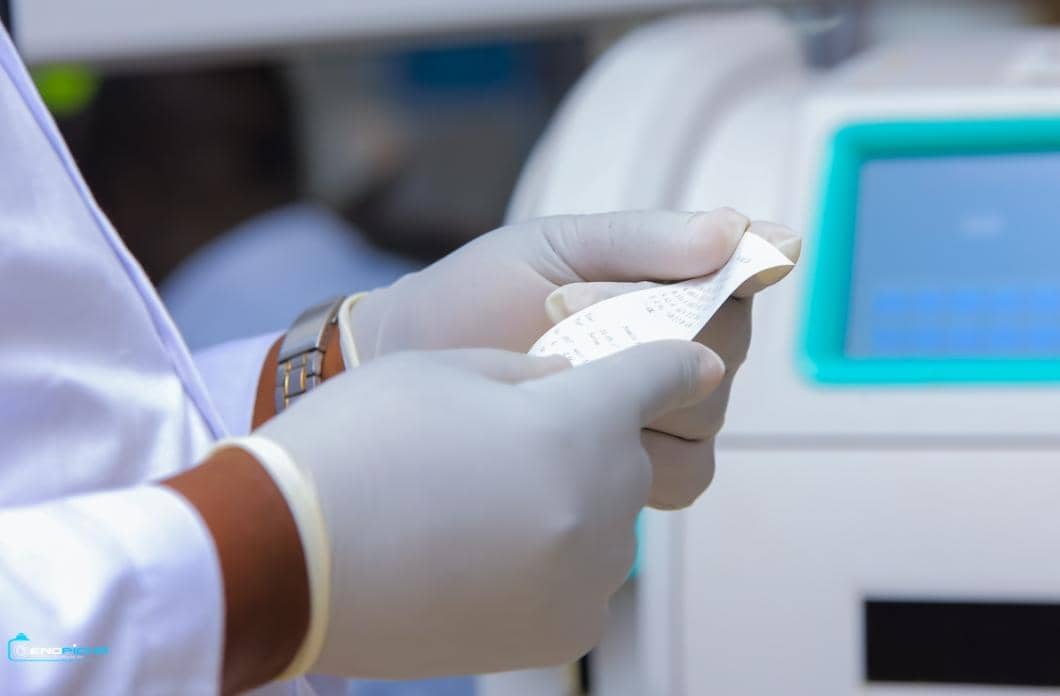
Cerebrospinal fluid (CSF) is a clear watery liquid filtrate that is formed by the choroid plexus, a special tissue that has many blood vessels and lines the small spaces or chambers (ventricles) in the brain. CSF flows around the brain and spinal cord, surrounding and protecting them. CSF is continually produced, circulated, and then absorbed into the blood system. About 500 mL is produced each day. This rate of production means that all of the CSF is replaced every few hours.
A protective blood-brain barrier separates the brain from circulating blood and regulates the distribution of substances between the blood and the CSF. The barrier helps keep large molecules, toxins, and most blood cells away from the brain. Any condition that disrupts this protective barrier may result in a change in the normal level or type of constituents of CSF. Because CSF surrounds the brain and spinal cord, testing a sample of CSF can be very valuable in diagnosing a variety of diseases affecting the central nervous system (CNS). Although a sample of CSF may be more difficult to obtain than, for example, urine or blood, the results may reveal more directly the cause of brain-related symptoms.
For example, infections and inflammation in the meninges (called meningitis) or the brain (called encephalitis) can disrupt the blood-brain barrier and allow white and red blood cells and increased amounts of protein into the CSF. Meningitis and encephalitis can also lead to the production of antibodies. Immune diseases that affect the CNS, such as Guillain-Barré Syndrome, and multiple sclerosis can also produce antibodies that can be found in the CSF. Cancers such as leukaemia can lead to an increase in CSF white blood cells (WBCs), and cancerous tumours can result in the presence of abnormal cells. These changes from normal CSF constituents make the examination of cerebrospinal fluid valuable as a diagnostic tool.
CSF analysis usually involves an initial basic set of tests performed when CSF analysis is requested:
A wide variety of other tests may be requested as follow-up depending on the results of the first set of tests. The specific tests that are requested may also depend on the signs and symptoms of the patient and the disease the doctor suspects is the cause. Each of these tests can be grouped according to the type of examination that is performed:
Cerebrospinal fluid (CSF) analysis may be used to help diagnose a wide variety of diseases and conditions affecting the central nervous system (CNS). They may be divided into four main categories:
CSF analysis may be requested when a doctor suspects that a patient has a condition or disease involving their CNS. A patient’s medical history may prompt the request for CSF analysis. It may be requested when a patient has suffered trauma to the brain or spinal cord, has been diagnosed with cancer that may have spread (metastatic) or has signs or symptoms suggestive of a condition involving their CNS.
The signs and symptoms of CNS conditions can vary widely and many overlap with a variety of diseases and disorders. They may have sudden onset, suggesting an acute condition such as CNS bleeding or infection or may be slow to develop, indicating a chronic disease such as cancer or multiple sclerosis.
Depending on a patient’s history, doctors may request CSF analysis when some combination of the following signs and symptoms appear:
These tests are used to help diagnose, evaluate, and monitor people suspected of having Acute Coronary Syndrome (ACS). |
||||||
| MARKER | WHAT IT IS | TISSUE SOURCE | REASON FOR INCREASE | TIME TO INCREASE | TIME BACK TO NORMAL | WHEN/HOW USED |
Cardiac Troponin |
Regulatory protein complex; two cardiac-specific isoforms: T and I | Heart | Injury to heart | 3 to 4 hours | Remains elevated for 10 to 14 days | Diagnose heart attack, risk stratification, assist in deciding management, assess degree of damage |
High-sensitivity cardiac troponin |
Same as above, just measures the same protein at a much lower level | Heart | Injury to heart | Within 3 hours of onset of symptoms | Same as above | Same as above; may also be elevated in stable angina and people without symptoms and indicates risk of future cardiac events (e.g., heart attacks) |
CK |
Enzyme; total of three different isoenzymes | Heart, brain, and skeletal muscle | Injury to skeletal muscle and/or heart cells | 3 to 6 hours after injury, peaks in 18 to 24 hours | 48 to 72 hours, unless due to continuing injury | Frequently performed in combination with CK-MB; sometimes to detect second heart attack occurring shortly after the first |
CK-MB |
Heart-related isoenzymes of CK | Heart primarily, but also in skeletal muscle | Injury to heart and/or muscle cells | 3 to 6 hours after heart attack, peaks in 12 to 14 hours | 48 to 72 hours, unless new or continuing damage | Less specific than troponin, may be ordered when troponin is not available |
Myoglobin |
Oxygen-storing protein | Heart and other muscle cells | Injury to muscle and/or heart cells | 2 to 3 hours after injury, peaks in 8 to 12 hours | Within one day after injury | Used less frequently; sometimes performed with troponin to provide early diagnosis |
